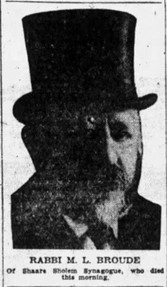Shaare Sholem Synagogue
Introduction
Text-to-speech Audio
When Jewish immigrants from Eastern Europe began to arrive in St. Joseph in the 1880s they found a thriving Jewish community whose roots went back to Germany. From the beginning, the world-view of the two communities clashed. The Eastern European immigrants, primarily from Russia, tended to be more conservative and less economically successful than those from Germany. This difference prompted those with more conservative views to form their own congregation – Shaare Sholem.
Images

Backstory and Context
Text-to-speech Audio
The 1888 and 1889 city directories state that the “Orthodox Jewish Church, Rev. Aaron Hurwitz, Pastor” was meeting at 209 Felix. In 1895 the Shaare Sholem congregation was meeting in a rental hall at 601 Angelique St. In July 1899, they purchased a lot on which to build at 7th and Patee [725 S. 7th St.] streets. According to the St. Joseph Herald, “The congregation of the church is small, numbering only sixty-five members. . . Unlike the Christian and reformed Jewish church, the orthodox Jews have no sermons at their meetings. The services are simple, consisting of the reading of prayers. No rabbi is employed by the church, the different members serving at the gatherings every Saturday.” In 1915 the congregation hired a rabbi – M.L. Broude, a recent Polish (when it was under the control of Russia) immigrant. Rabbi Broude was known for his intellectualism. Just before his death in 1929, the congregation conducted a very public squabble over who would lead the synagogue. Some of the congregation supported Broude while others supported Rabbi Baruch Lebovitz who arrived from Laredo, TX to take the pulpit. Those who supported Lebovitz argued that Broude was too old to be an effective leader. Following Rabbi Broude’s death in 1929 (he is buried at Shaare Sholem cemetery), leadership of the congregation passed to Rabbi Iser Levine. The Levine family came to the United States from Lithuania in 1929, settling first in Chicago before coming to St. Joseph in March 1930. He served the congregation until his death of heart failure and cancer in 1945. The congregation and its leaders were active in the civic affairs of the city, playing important roles in the war efforts and providing support to the poor. However, the congregation did not always get along with its neighbors. In 1930, several members of Shaare Sholem Synagogue filed a petition with the police asking them to close several “notorious bawdy houses” that were operating in the neighborhood.
In 1950, Shaare Sholem began serious discussions with B’nai Yaakov Temple concerning the possible merger of the two congregations. Those initial talks did not come to fruition and during the 1950s, Shaare Sholem contemplated replacing their old temple with a new structure. In 1960, the issue was opened again and this time the two congregations did merge. The decision was that the combined congregation would meet at B’nai Yaakov on S. 10th Street; they renamed that synagogue B’nai Sholem. Crouch Brothers Truck Lines purchased the building that had housed Shaare Sholem Temple. It was demolished in 1961 and now there is only an empty lot across from a metal commercial structure where this once vibrant congregation met and worshipped.
Cite This Entry
Schutte, Kim. "Shaare Sholem Synagogue." Clio: Your Guide to History. November 16, 2022. Accessed March 28, 2025. https://theclio.com/tour/2349/8
Sources
“New Jewish Temple,” St. Joseph Herald, July 13, 1899, pg. 3.
“Differ Over Rabbi,” St. Joseph News-Press, Feb. 9, 1929, pg. 7
“Rabbi Broude Dead,” St. Joseph News-Press, May 3, 1929, pg. 7.
“A Petition to Police,” St. Joseph News-Press, June 4, 1930, pg. 7.
“Untitled” St. Joseph News Press, March 30, 1936, pg. 6;
“Miss Ruth Levin engaged to Marry Milton A. Saffir,” St. Joseph News-Press, Feb. 27, 1938, pg. 18.
“Death Takes Rabbi Levine,” St. Joseph News-Press, Sept. 12, 1945, pg. 4
“Miss Levin Weds Today,” St. Joseph News-Press, Dec. 30, 1945, pg. 17.
“Merger Closes Old Synagogue,” St. Joseph Gazette, Aug. 31, 1950, pg. 1
“2 Jewish Congregation in Move to Consolidate,” St. Joseph Gazette, June 7, 1960, pg. 3

